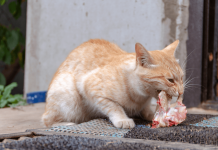Cats get infected with worms is not uncommon. The house cats and the outdoor cats often get worms in their little intestine. Though getting worms is not life-threatening, ignoring the condition can damage the feline’s health.
So, what causes worms in cats? How to treat worms in cats? Is it possible to get rid of the worms using home remedies? I know questions like these are storming on your mind.
I decided to answer all your questions and discuss more on the worms in cats. In this article, you will get to know the types of worms that a cat can get and their treatment. So, let’s start.
Types of Worms in Cats

Worms are basically the intestinal parasites. After getting into a cat’s intestine, the worms start growing. They depend on the nutrients of the cats to live. A worm has both the male and female reproductive organs, and so, expanding the population is a lot easier for them.
A feline can get 6 basic types of worms. For example,
- Tapeworm
- Whipworm
- Roundworm
- Lungworm
- Heartworm
- Hookworm
There are many more types of worms, but these are the most common in cats. In the upcoming sections, I will discuss these in detail.
Now you know the common types of worms in cats. Let’s see how the cats get these worms and how to treat it:
1. Tapeworms in cats
Cat tapeworms are flat, long, and white. These parasites have a hook-like mouth, which helps them to anchor onto the intestine wall of the cat. The tapeworms absorb the health and nutrients from the cat via this hook-like mouth. An adult tapeworm can grow 8 inches and in many cases, the parasites will have a length of 20 inches.
The cats get the tapeworms through fleas and other infected small animals. If the cat digests infected flea larvae, the pet will surely get infected by the tapeworm. However, when your feline comes in contact with an infected small animal like a lizard or rodent, the worm can transmit to the pet.
How will you know your cat has got tapeworms? Usually, a sick cat will be vomiting up the pieces of these white worms. The pet will start losing weight. Also, you will see these fatty white rice-sized worms in the cat’s feces. The cat might feel irritated in its skin.
To treat the tapeworms, you need to take the cat to a vet. The vet will offer a deworming course and the cat will be healthy within a short time. Flea treatment can also help the cat to get rid of tapeworms.
2. Whipworms in cats
Whipworms are small in size and quite common in cats. Though this is a minor condition, it should be handled carefully. A cat can get whipworm if it gets in contact with anything contaminated with this parasite. The whipworms can live on the soil, food, and water.
At the beginning stage, the cat will show no sign of the parasite. But once the whipworms start multiplying, the cat will exhibit some symptoms. Such as:
- Weight loss
- Dehydration
- Blood in feces
- Inflammation while peeing
- Diarrhea
Deworming the cat via medication is the best way to treat this condition. If the cat suffers from inflammation, the vet may prescribe an anti-inflammatory drug.
3. Roundworms in cats
A cat can get roundworms in many ways. It can transmit to the kitten from the infected mother via milk. Also, if the cat swallows the roundworm eggs with food or anything, it will probably get a roundworm infection.
Getting roundworms is not a serious case. But if you ignore the condition, it can cause death to the feline. The thing is roundworms are actually harmless. When they grow large in number, then the tube begins.
What are the clinical signs of roundworms in cats? The pet will lose appetite, vomit frequently. You will notice worms in the puke and stool. The feline may suffer from diarrhea and abdominal discomfort. However, the coat also looks dull.
Treating roundworms is actually easy. After giving deworming medicine, the worms and worm eggs come out with eggs. Within a month or less, the cat will become fully healthy.
4. Lungworm in cats
The lungworms are more of a serious case and life-threatening. An adult lungworm can be alive for around 2 years in the respiratory organ and expand the population. These parasites will weaken the cat’s immunity. And so, the feline will get other secondary diseases.
The worst part about the lungworm is the diagnosis and the symptoms are nonspecific. Coughing, sneezing, nasal discharge, lethargy, short breath, weight loss, depression are some of the probable symptoms of lungworms. A cat usually gets lungworm larvae from other infected animals like mice, rodents, or lizards. However, if the cat accidentally digests these worm eggs, it will get infected.
How to treat worms in cats? Honestly speaking, prevention is the best way in this case. Treating the lungworms will require expert advice and support.
5. Heartworm in cats
Heartworm disease in cats is more severe than one in dogs. Even if the cat gets a small number of worms in its heart, the feline is considered heavily infected. A cat generally gets the heartworm via the mosquito bitings.
The diagnosis of heartworm is a bit difficult. The vet suggests a blood test to be exactly sure. Like the lungworm, the symptoms of this disease are also nonspecific. Some cats show symptoms of heart failure.
There is no available treatment for the heartworms of cats. So, it is better to prevent by deworming the feline once or twice a year.
6. Hookworms in cats
Hookworms are small in size, but with their hook-like mouth, they can get a strong grip on the cat’s intestine. Usually, a cat gets hookworm by ingesting worm larvae. The clinical signs of this infection are lethargy, dull coat, bloody stool, etc.
Deworming the cat will be the best treatment if it has hookworms. The parasites will be dead after one or two doses. Giving the kitten vaccine will be a smart way to prevent these parasites.
Worms are not anything serious in cats. But ignoring the condition can harm the cat’s health. I hope this article on how to treat worms in cats will be a great help for you.
Related: What is FIP in Cats? Symptoms & Diagnosing of FIP in Cats






































